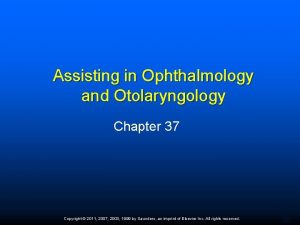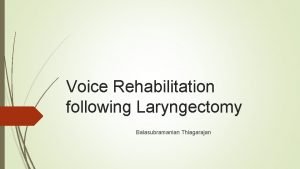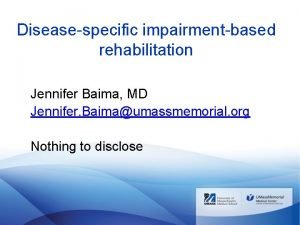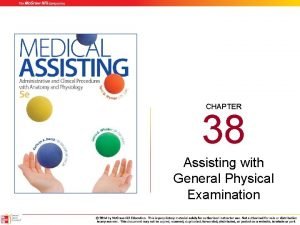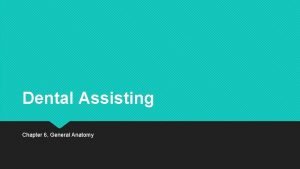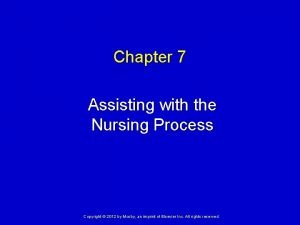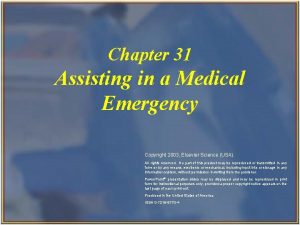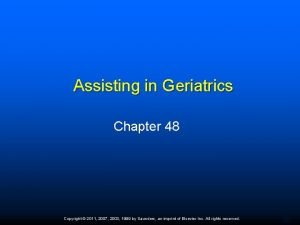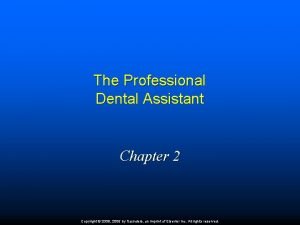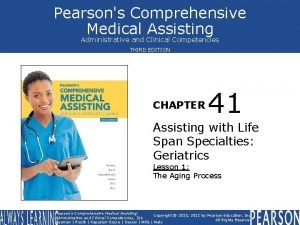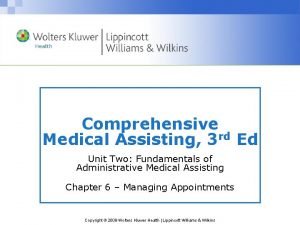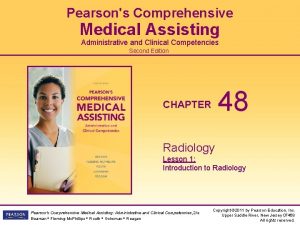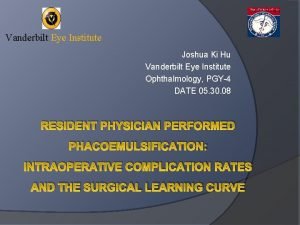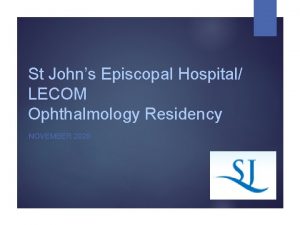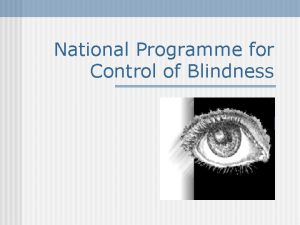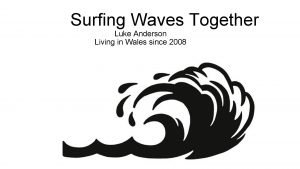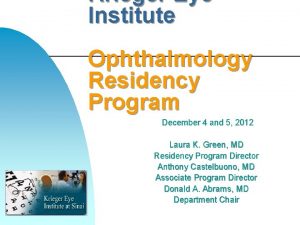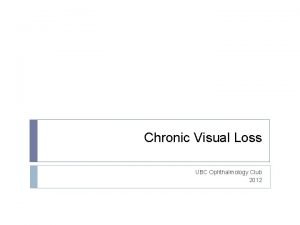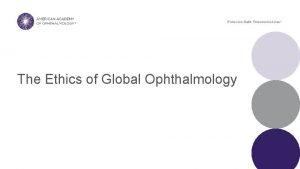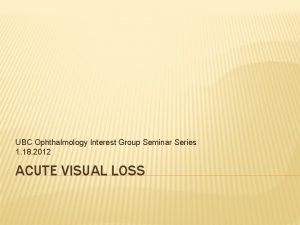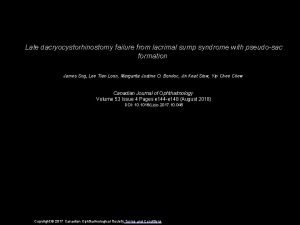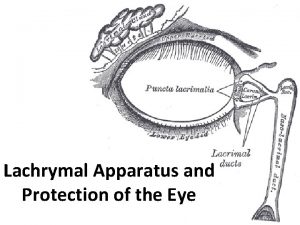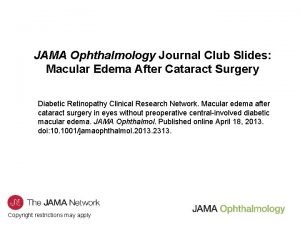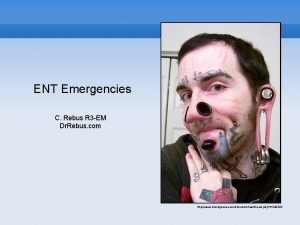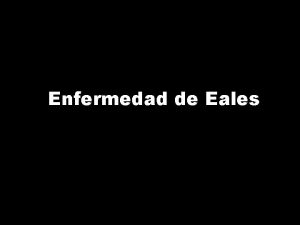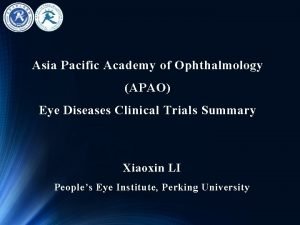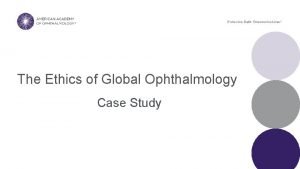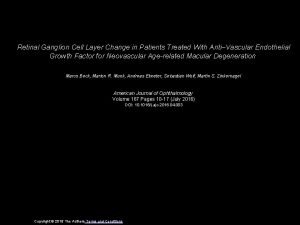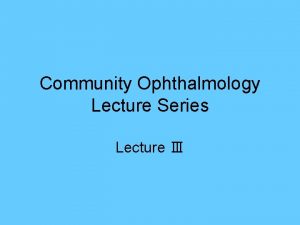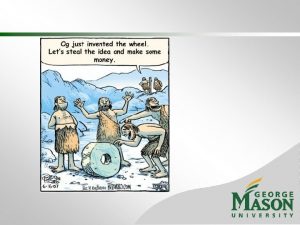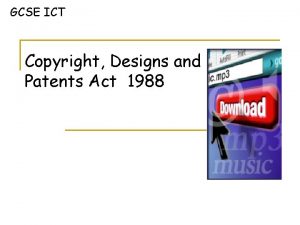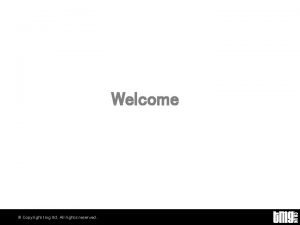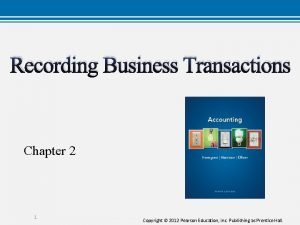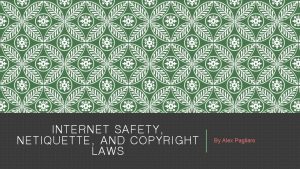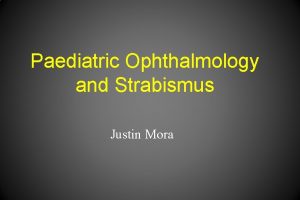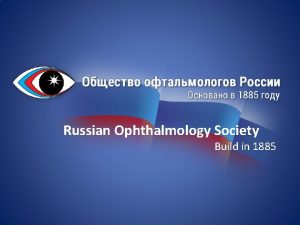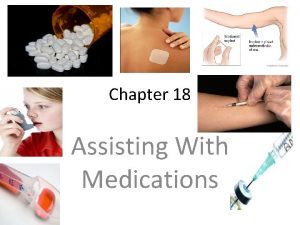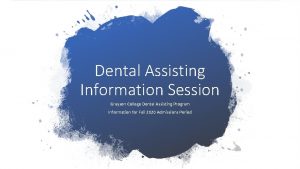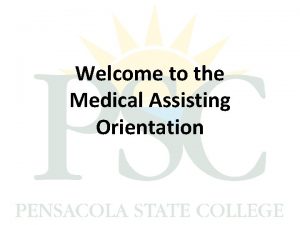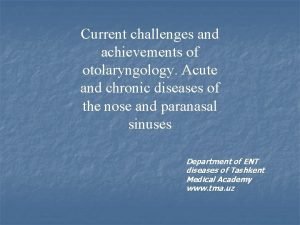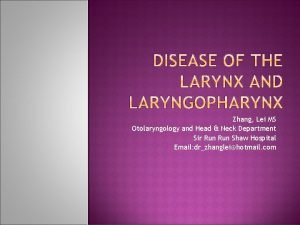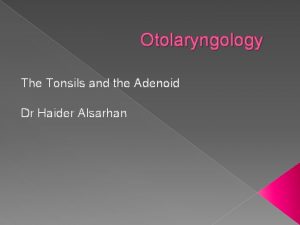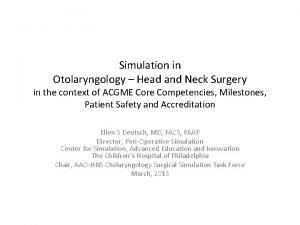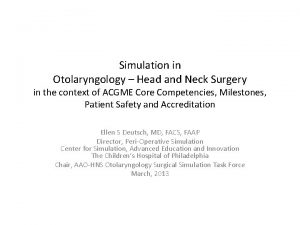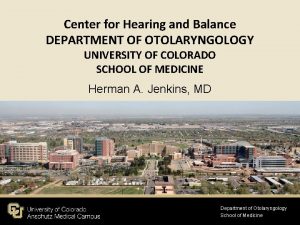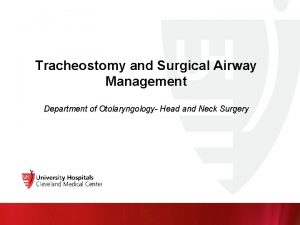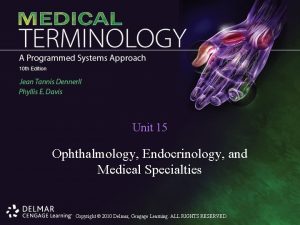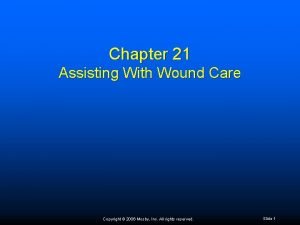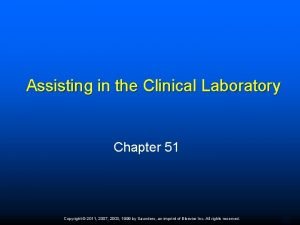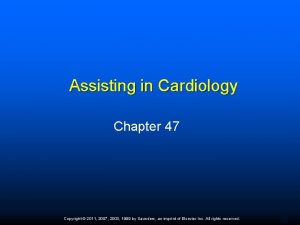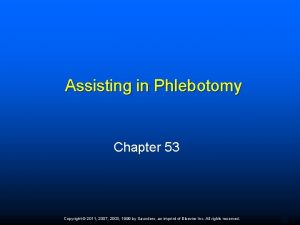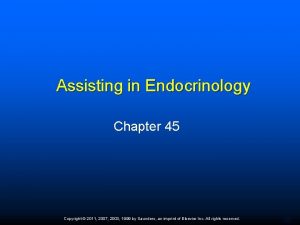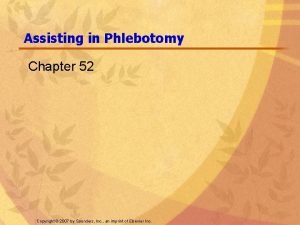Assisting in Ophthalmology and Otolaryngology Chapter 37 Copyright




















































- Slides: 52

Assisting in Ophthalmology and Otolaryngology Chapter 37 Copyright © 2011, 2007, 2003, 1999 by Saunders, an imprint of Elsevier Inc. All rights reserved. 1

Learning Objectives Define, spell, and pronounce the terms listed in the vocabulary. Apply critical thinking skills in performing patient assessment and care. Explain the differences among an ophthalmologist, optometrist, and optician. Identify the anatomic structures of the eye. Describe how vision occurs. Differentiate among the major types of refractive errors. Copyright © 2011, 2007, 2003, 1999 by Saunders, an imprint of Elsevier Inc. All rights reserved. 2

Learning Objectives Summarize typical disorders of the eye. Define the various diagnostic procedures for the eye. Conduct a vision acuity test using the Snellen chart. Assess color acuity. Illustrate the purpose of eye irrigations and the instillation of medication. Properly irrigate a patient’s eyes. Accurately instill eye medication. Copyright © 2011, 2007, 2003, 1999 by Saunders, an imprint of Elsevier Inc. All rights reserved. 3

Learning Objectives Identify the structures and explain the functions of the external, middle, and internal ear. Describe the conditions that can lead to hearing loss, including conductive, neurogenic, and congenital hearing losses. Define the major disorders of the ear, including otitis, impacted cerumen, and Ménière’s disease. Explain the various otic diagnostic procedures. Accurately measure the hearing acuity of a patient by using an audiometer. Copyright © 2011, 2007, 2003, 1999 by Saunders, an imprint of Elsevier Inc. All rights reserved. 4

Learning Objectives Identify the purpose of ear irrigations and instillation of ear medication. Demonstrate ear irrigations. Accurately instill otic drops. Summarize the nose and throat examination. Perform a throat culture. Describe the effect of sensory loss on patient education. Copyright © 2011, 2007, 2003, 1999 by Saunders, an imprint of Elsevier Inc. All rights reserved. 5

Examination of the Eye The ophthalmologist is a medical physician specializing in the diagnosis and treatment of the eye. The optometrist examines and treats visual defects. An optician fills prescriptions for corrective lenses. Copyright © 2011, 2007, 2003, 1999 by Saunders, an imprint of Elsevier Inc. All rights reserved. 6

Anatomy and Physiology of the Eye The anatomy of the eye begins with the outer covering, the conjunctiva, and the three layers of tissue: sclera, choroid, and retina. The retina in the inner layer of the eye is where light rays are converted into nervous energy for interpretation by the brain. The lens is a transparent body that helps focus light after it passes through the cornea. The posterior cavity contains vitreous humor and the anterior cavity contains aqueous humor. Copyright © 2011, 2007, 2003, 1999 by Saunders, an imprint of Elsevier Inc. All rights reserved. 7

Anatomy and Physiology of the Eye Copyright © 2011, 2007, 2003, 1999 by Saunders, an imprint of Elsevier Inc. All rights reserved. 8

Vision Vision begins with the passage of light through the cornea, where it is refracted and then passes through the aqueous humor and pupil into the lens. The ciliary muscle adjusts the curvature of the lens to refract the light rays so they pass into the retina, triggering the photoreceptor cells of the rods and cones. Light energy is then converted into an electrical impulse, which is sent through the optic nerve to the brain, where interpretation occurs. Copyright © 2011, 2007, 2003, 1999 by Saunders, an imprint of Elsevier Inc. All rights reserved. 9

Disorders of the Eye Refractive errors: Hyperopia Ø Myopia Ø Presbyopia Ø Astigmatism Ø All are caused by a problem with bending light so it can be accurately focused on the retina. They are usually caused by defects in the shape of the eyeball and can be corrected with glasses, contact lenses, or surgery. Copyright © 2011, 2007, 2003, 1999 by Saunders, an imprint of Elsevier Inc. All rights reserved. 10

Refractive Errors Copyright © 2011, 2007, 2003, 1999 by Saunders, an imprint of Elsevier Inc. All rights reserved. 11

Signs and Symptoms of Refractive Errors Squinting Frequent rubbing of the eyes Headaches Blurring of vision and/or fading of words at reading level Some refractive errors are familial in nature Copyright © 2011, 2007, 2003, 1999 by Saunders, an imprint of Elsevier Inc. All rights reserved. 12

Treatment of Refractive Errors Eyeglasses and contact lenses Photorefractive Keratectomy (PRK) Laser-Assisted In-Situ Keratomileusis (LASIK) Laser-Assisted Epithelial Keratomileusis (LASEK) Conductive Keratoplasty (CK) Copyright © 2011, 2007, 2003, 1999 by Saunders, an imprint of Elsevier Inc. All rights reserved. 13

Surgical Corrections of Refractive Errors Photorefractive Keratectomy – laser reshapes the central cornea; procedure replaced by LASIK. Laser-Assisted In-Situ Keratomileusis – excimer laser reshapes the central cornea Laser-Assisted Epithelium Keratomileusis – softens the eye’s surface with an alcohol solution, allowing the epithelial layer to be rolled back and cornea to be seen; laser is used to reshape the cornea Conductive Keratoplasty (CK) – laser heat is applied to the cornea’s outer edge so it tightens and makes the cornea steeper Copyright © 2011, 2007, 2003, 1999 by Saunders, an imprint of Elsevier Inc. All rights reserved. 14

Disorders Strabismus—eyes do not track together Ø Amblyopia Nystagmus Infections of the eye: Hordeolum Ø Chalazions Ø Keratitis Ø Conjunctivitis Ø Blepharitis Ø Copyright © 2011, 2007, 2003, 1999 by Saunders, an imprint of Elsevier Inc. All rights reserved. 15

Corneal Abrasions Symptoms include pain, inflammation, tearing, photophobia Caused by trauma or foreign body in eye Diagnosed – physician applies fluorescein stain to eye, uses a cobalt-blue filtered light to visualize the abrasions, which will appear green Treatment – antibiotic ophthalmic ointment to prevent infection, topical nonsteroidal antiinflammatory (NSAID) ophthalmic ointments such as diclofenac (Voltaren) and ketorolac (Acular) as well as oral analgesics Copyright © 2011, 2007, 2003, 1999 by Saunders, an imprint of Elsevier Inc. All rights reserved. 16

Cataracts – opaque changes in the lens; cause blurred, less acute vision. Diagnosis made with a slit lamp Treatment – outpatient surgical removal of lens and placement of artificial lens Extracapsular extraction removes cataract in one piece Ø Phacoemulsification – ultrasonic probe breaks up cataract and then pieces are aspirated Ø Artificial intraocular lens (IOL) is implanted Ø Copyright © 2011, 2007, 2003, 1999 by Saunders, an imprint of Elsevier Inc. All rights reserved. 17

Glaucoma Aqueous humor builds up, increasing intraocular pressure and decreasing blood supply to retina and optic nerve Signs and symptoms – frequent need to change eyeglass prescriptions, loss of peripheral vision, mild headaches, and impaired adaptation to the dark Diagnosis – tonometer and eye examination Treatment – miotic drops, beta-blockers, or laser surgery Copyright © 2011, 2007, 2003, 1999 by Saunders, an imprint of Elsevier Inc. All rights reserved. 18

Macular Degeneration Macula lutea is part of the retina and defines the center of the field of vision Progressive deterioration of macula lutea causes progressive loss of central vision Age-related; no cure Ø antioxidants including carotene, selenium, zinc, and vitamins C and E may prevent the condition or slow its progress Copyright © 2011, 2007, 2003, 1999 by Saunders, an imprint of Elsevier Inc. All rights reserved. 19

Diagnostic Procedures Diagnostic procedures for the eye begin with examination of the eye with an ophthalmoscope. Next the eyelids are examined for abnormalities. Pupils are assessed for PERRLA: Ø Pupils equal round and reactive to light and accommodation More advanced techniques include the use of a slit lamp to view the fine details of the eye and the exophthalmometer to measure the pressure in the central renal artery. Copyright © 2011, 2007, 2003, 1999 by Saunders, an imprint of Elsevier Inc. All rights reserved. 20

Diagnostic Procedures: Slit Lamp Copyright © 2011, 2007, 2003, 1999 by Saunders, an imprint of Elsevier Inc. All rights reserved. 21

Distance Visual Acuity Distance visual acuity is typically assessed using a Snellen chart. May use E chart, pediatric picture chart, or alphabet chart Ø Patient stands 20 feet from chart at eye level Ø Eyes tested with corrective lenses worn Ø Record results as fraction with 20 feet on top Ø Both eyes remain open during the examination; no squinting or straining Ø Abbreviations: OD (right), OS (left), OU (both) Ø Copyright © 2011, 2007, 2003, 1999 by Saunders, an imprint of Elsevier Inc. All rights reserved. 22

Types of Snellen Charts Copyright © 2011, 2007, 2003, 1999 by Saunders, an imprint of Elsevier Inc. All rights reserved. 23

Critical Thinking Application Susie Anthony, a 19 -year-old patient, is seen today for a general eye examination. The physician orders a routine Snellen test, and Kim administers it. Susie wears contacts and with the right eye reads without errors to the 20/25 line but squints and makes three errors at the 20/20 line. With the left eye Susie makes two mistakes at the 20/30 line. How should Kim document this procedure? Copyright © 2011, 2007, 2003, 1999 by Saunders, an imprint of Elsevier Inc. All rights reserved. 24

Vision Screening Near visual acuity is tested with a near-vision acuity chart; size of type varies. Helps with diagnosis of presbyopia Ø Give in well-lit room, with patient holding card 14 to 16 inches away Ø Given in each eye; monitor patient for squinting or straining Ø The Ishihara test assesses color vision defects. Usually inherited by son from mother Ø Test detects total colorblindness as well as red-green blindness that occurs with genetic type Ø Patient shown colored dots in numeric patterns; requires sunlight Ø Copyright © 2011, 2007, 2003, 1999 by Saunders, an imprint of Elsevier Inc. All rights reserved. 25

Treatment Procedures: Irrigations Eye irrigations relieve inflammation, remove drainage, dilute chemicals, or wash away foreign bodies. Sterile technique and equipment must be used to avoid contamination. Pour solution from inner canthus out, with head tilted toward the affected eye. Procedure 37 -3 Copyright © 2011, 2007, 2003, 1999 by Saunders, an imprint of Elsevier Inc. All rights reserved. 26

Eye Irrigation Copyright © 2011, 2007, 2003, 1999 by Saunders, an imprint of Elsevier Inc. All rights reserved. 27

Ophthalmic Medication Procedures Medication may be instilled into the eye for treatment of an infection, to soothe an eye irritation, to anesthetize the eye, or to dilate the pupils before examination or treatment. Eye drops—do not touch anything with applicator; insert into lower conjunctival sac while patient looks up. Eye ung—sterile procedure; apply thin ribbon of medication in lower conjunctival sac. Patient should gently close eye after application and rotate eyeball to disperse medication. Refer to Table 37 -2 Copyright © 2011, 2007, 2003, 1999 by Saunders, an imprint of Elsevier Inc. All rights reserved. 28

Asepsis and Ophthalmic Medications A major concern in ophthalmologic procedures is the contamination of eye medication applicators Use of stock ophthalmic medications is discouraged Sterility of eye medications is critical Newly opened sterile solutions should be used for each patient and either disposed of after instillation or given to the patient for home use All instruments used for the removal of a foreign body in the eye should be sterile Copyright © 2011, 2007, 2003, 1999 by Saunders, an imprint of Elsevier Inc. All rights reserved. 29

Examination of the Ear Otorhinolaryngology Usually the specialty otorhinolaryngology is referred to simply as ear, nose, and throat (ENT). Copyright © 2011, 2007, 2003, 1999 by Saunders, an imprint of Elsevier Inc. All rights reserved. 30

Anatomy and Physiology of the Ear The external ear consists of the auricle or pinna and the external auditory canal, which transmits sound waves to the tympanic membrane. The middle ear is an air-filled cavity that contains the ossicles (malleus, incus, stapes). The sound vibration passes through the tympanic membrane, causing the ossicles to vibrate. This bone-conducted vibration passes through the oval window into the inner ear. The organ of Corti in the cochlea of the inner ear converts the sound waves into nervous energy that is sent to the brain for interpretation. The semicircular canals in the inner ear maintain equilibrium. Copyright © 2011, 2007, 2003, 1999 by Saunders, an imprint of Elsevier Inc. All rights reserved. 31

Anatomy of the Ear Modified from Jarvis C: Physical examination and health assessment, ed 4, Philadelphia, 2004, Saunders. Copyright © 2011, 2007, 2003, 1999 by Saunders, an imprint of Elsevier Inc. All rights reserved. 32

Disorders of the Ear Conductive hearing loss originates in the external or middle ear; prevents sound vibrations from passing through the external auditory canal, limits vibration of the tympanic membrane, or interferes with passage of bone-conducted sound in the middle ear. Patient can benefit from a hearing aid. Caused by impacted cerumen Ø trauma to tympanic membrane Ø otosclerosis Ø chronic otitis media Ø Copyright © 2011, 2007, 2003, 1999 by Saunders, an imprint of Elsevier Inc. All rights reserved. 33

Disorders of the Ear Sensorineural hearing loss – results from damage to the organ of Corti or the auditory nerve; prevents sound vibration from becoming nervous stimuli that can be interpreted by the brain as sound. Ø Caused by rubella in utero, influenza, head trauma, ototoxic medications, prolonged exposure to loud noise Presbycusis – hearing loss that affects aging people, is caused by a reduced number of receptor cells in the organ of Corti Tinnitus – ringing in the ears Copyright © 2011, 2007, 2003, 1999 by Saunders, an imprint of Elsevier Inc. All rights reserved. 34

Causes of Deafness From Damijanov I: Pathology for the health-related professions, ed 3, Philadelphia, 2006, Saunders. Copyright © 2011, 2007, 2003, 1999 by Saunders, an imprint of Elsevier Inc. All rights reserved. 35

Disorders of the Ear Otitis externa Ø Affects the external ear canal and is called otitis externa, or swimmer's ear Ø Caused by bacterial or fungal infection, psoriasis, trauma to the canal Copyright © 2011, 2007, 2003, 1999 by Saunders, an imprint of Elsevier Inc. All rights reserved. 36

Disorders of the Ear Otitis media—inflammation of the normally air-filled middle ear, resulting in a collection of fluid behind the tympanic membrane (TM). Otitis media: Serous—buildup of clear fluid with full feeling and hearing loss Ø Suppurative—purulent fluid with fever, pain, hearing loss; caused by URI or allergic reaction Ø Diagnosed with otoscopy—pearly gray TM is inflamed and bulging Ø Tympanogram—determines air pressure of middle ear and mobility of TM Ø Copyright © 2011, 2007, 2003, 1999 by Saunders, an imprint of Elsevier Inc. All rights reserved. 37

Diagnosis and Treatment of Otitis Media Otoscopic examination – TM inflamed and bulging; fluid or pus may be visible through the membrane Tympanogram – determine the air pressure of the middle ear and mobility of the tympanic membrane Antibiotics, analgesics, and decongestant prescribed Myringotomy – done to treat chronic otitis media surgical incision in the tympanic membrane to drain the fluid Ø insert tympanostomy tube to continually drain the middle ear of fluid. Ø may help prevent permanent hearing loss because of damage to the ossicles Ø Copyright © 2011, 2007, 2003, 1999 by Saunders, an imprint of Elsevier Inc. All rights reserved. 38

Recommendations for Treatment of Otitis Media Delay treatment with antibiotics for 24– 72 hours; if no improvement prescribe an appropriate antibiotic Complete medication as ordered to prevent infection from recurring May treat otitis media with a short course of antibiotics— 5 days—but with a higher dose Antibiotics will not help if otitis is caused by a virus Parental education important – why antibiotic therapy may not be recommended; importance of administering antibiotic as ordered Copyright © 2011, 2007, 2003, 1999 by Saunders, an imprint of Elsevier Inc. All rights reserved. 39

Ear Inflammations From Damijanov I: Pathology for the health-related professions, ed 3, Philadelphia, 2006, Saunders. Copyright © 2011, 2007, 2003, 1999 by Saunders, an imprint of Elsevier Inc. All rights reserved. 40

Disorders of the Ear Impacted cerumen An excessive secretion of cerumen can gradually cause hearing loss, tinnitus, a feeling of fullness, and otalgia (ear pain). Ø Cerumen pushed tightly up against the eardrum; frequent cause of conductive hearing loss Individuals with psoriasis, abnormally narrow ear canals, or an excessive amount of hair growing within the ear canals are more prone to this condition. Treated with ear irrigation. Copyright © 2011, 2007, 2003, 1999 by Saunders, an imprint of Elsevier Inc. All rights reserved. 41

Disorders of the Ear Ménière’s disease is a chronic, progressive condition that affects the labyrinth and causes recurring attacks of vertigo, tinnitus, a sensation of pressure in the affected ear, and advancing hearing loss. Treatment—salt-restricted diet, medications for nausea and vomiting, diuretics, antihistamines Can result in permanent deafness Copyright © 2011, 2007, 2003, 1999 by Saunders, an imprint of Elsevier Inc. All rights reserved. 42

Interview Questions for Ear Problems Are you experiencing nausea, vomiting, vertigo, otalgia, fever, headache, upper respiratory infection, tinnitus, drainage, loss of balance, or hearing loss? What are the onset, duration, and frequency of symptoms? Have you taken any medication for the symptoms? What? Has it been helpful? Is the problem bilateral? Are you experiencing pain? What number on the 1– 10 pain scale? Is it localized or radiating, one ear or both? Have you discovered anything that brings relief of symptoms? Copyright © 2011, 2007, 2003, 1999 by Saunders, an imprint of Elsevier Inc. All rights reserved. 43

Diagnostic Ear Procedures The ear examination begins with an otoscopic examination Tuning fork tests Rinne test Ø Weber test Ø Audiometric testing Ø Copyright © 2011, 2007, 2003, 1999 by Saunders, an imprint of Elsevier Inc. All rights reserved. 44

Diagnostic Ear Procedures Copyright © 2011, 2007, 2003, 1999 by Saunders, an imprint of Elsevier Inc. All rights reserved. 45

Treatment Procedures Ear irrigation—to remove excess cerumen Direct solution toward roof of canal Ø Abbreviations—AU (both), AD (right), AS (left) Ø Straightening ear canal Adult—pull pinna up and back Ø Child under 3 years—pull ear lobe down and back Ø Copyright © 2011, 2007, 2003, 1999 by Saunders, an imprint of Elsevier Inc. All rights reserved. 46

Critical Thinking Application Kim is ordered to perform a bilateral ear irrigation on a 68 -year-old patient with impacted cerumen. She checks the auditory canals before the procedure with an otoscope and sees a large amount of dark brown cerumen in the right ear completely covering the tympanic membrane. The left ear has a moderate amount of golden brown cerumen covering the bottom half of the tympanic membrane. After the procedure both membranes are visible, and the patient tolerated the procedure without complaints. How should Kim document the procedure? Copyright © 2011, 2007, 2003, 1999 by Saunders, an imprint of Elsevier Inc. All rights reserved. 47

Irrigation and Medication Ear irrigation is used to remove excessive or impacted cerumen; to remove a foreign body; or to treat the inflamed ear with an antiseptic solution. Medication instilled into the ear generally softens impacted cerumen, relieves pain, or fights an infectious pathogen. Copyright © 2011, 2007, 2003, 1999 by Saunders, an imprint of Elsevier Inc. All rights reserved. 48

Examination of Nose and Throat Examination of the nose and throat begins with the nasal cavity, then the throat and the nasopharynx Throat cultures may be done to determine the presence of a streptococcal infection collected by gently swabbing the back of the throat and the surfaces of the tonsils with a sterile swab Ø mouth and tongue should be avoided to prevent contamination of the swab Ø Copyright © 2011, 2007, 2003, 1999 by Saunders, an imprint of Elsevier Inc. All rights reserved. 49

Patient Education Patients with vision or hearing impairments face serious challenges and require individualized attention to meet their health education needs. Teaching adaptations may be required for these patients. Those with vision losses may need large-print forms and handouts, increased levels of lighting, or oral instructions rather than written ones. Copyright © 2011, 2007, 2003, 1999 by Saunders, an imprint of Elsevier Inc. All rights reserved. 50

Patient Education: Hearing Deficits Individuals with hearing deficits may benefit from printed instructions, demonstrations of how to manage treatments, or even sign language interpretation. Family members should be included in the patient’s treatment plan, and referrals to appropriate community or professional resources may be very beneficial. Copyright © 2011, 2007, 2003, 1999 by Saunders, an imprint of Elsevier Inc. All rights reserved. 51

HIPAA Applications Notice of Privacy Practices (NPP) – form developed by the facility that outlines the patient’s rights and the facility’s legal responsibilities to safeguard the patient’s protected health information Each new patient must be given an NPP at the first office visit Document must be in a language that the patient easily understands Patients with vision and hearing deficits might need help understanding the form Copyright © 2011, 2007, 2003, 1999 by Saunders, an imprint of Elsevier Inc. All rights reserved. 52
 Chapter 31 ophthalmology and otolaryngology
Chapter 31 ophthalmology and otolaryngology Panje prosthesis
Panje prosthesis Jennifer baima
Jennifer baima Chapter 42 assisting in other medical specialties
Chapter 42 assisting in other medical specialties Inspection auscultation percussion palpation
Inspection auscultation percussion palpation Chapter 6 general anatomy
Chapter 6 general anatomy Chapter 5 assisting with the nursing process
Chapter 5 assisting with the nursing process Chapter 31 assisting in a medical emergency
Chapter 31 assisting in a medical emergency Chapter 41 assisting in geriatrics
Chapter 41 assisting in geriatrics What credential is issued by the danb
What credential is issued by the danb Pearson's comprehensive medical assisting
Pearson's comprehensive medical assisting Chapter 42 assisting in other medical specialties
Chapter 42 assisting in other medical specialties Assisting in microbiology and immunology
Assisting in microbiology and immunology Medical assistant rop
Medical assistant rop Procedure of welcoming the guest
Procedure of welcoming the guest Advertise past participle
Advertise past participle Pearson's comprehensive medical assisting
Pearson's comprehensive medical assisting Vanderbilt ophthalmology residency
Vanderbilt ophthalmology residency St. john's episcopal hospital ophthalmology residency
St. john's episcopal hospital ophthalmology residency National tb control program
National tb control program Ophthalmology medical terminology
Ophthalmology medical terminology Luke anderson ophthalmology
Luke anderson ophthalmology Kennedy krieger
Kennedy krieger Ubc ophthalmology
Ubc ophthalmology Ophthalmology code of ethics
Ophthalmology code of ethics Ophthalmology
Ophthalmology Ubc ophthalmology
Ubc ophthalmology Miosis vs mydriasis
Miosis vs mydriasis Sump syndrome
Sump syndrome Veterinary ophthalmology
Veterinary ophthalmology Jama ophthalmology impact factor
Jama ophthalmology impact factor Nasostat
Nasostat Enfermedad de eales
Enfermedad de eales Asia-pacific academy of ophthalmology
Asia-pacific academy of ophthalmology Ophthalmology case study
Ophthalmology case study 16710-17
16710-17 Alan bird ophthalmology
Alan bird ophthalmology Ophthalmology lecture
Ophthalmology lecture Difference between copyright and patent
Difference between copyright and patent What is the copyright designs and patents act 1988
What is the copyright designs and patents act 1988 What is the copyright designs and patents act 1988
What is the copyright designs and patents act 1988 Copyright and fair use guidelines for teachers
Copyright and fair use guidelines for teachers I the lord of sea and sky copyright
I the lord of sea and sky copyright Electronic copyright office
Electronic copyright office Tmg copyright
Tmg copyright Copyright houghton mifflin company
Copyright houghton mifflin company The hunger games copyright
The hunger games copyright Copyright is debit or credit in trial balance
Copyright is debit or credit in trial balance Copyright 2015 all rights reserved
Copyright 2015 all rights reserved Population growth factors
Population growth factors Nist sp 800-53 rev. 5
Nist sp 800-53 rev. 5 Copyright 2008
Copyright 2008 Proper netiquette practices to avoid copyright issues
Proper netiquette practices to avoid copyright issues
